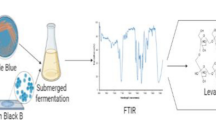Summary
Submerged fermentation of Claviceps paspali strain MG-6 was studied with regard to the fate of individual alkaloids in the course of fermentation. Based on liquid-chromatographic data the process can be divided into three phases. The production phase (fermentation days 3–12) is characterized by biosynthesis of the basic genuine alkaloid, lysergic acid alpha-hydroxyethylamide (LAH I). In view of its low stability it becomes epimerized on two asymmetric carbon atoms in the fermentation medium, yielding three other epimers (LAH II–IV). The degradation phase (days 13–18) involves cleavage of LAH I–IV resulting in ergine and erginine. In the post-production phase (days 15–30) the alkaloids succumb to biooxidative reactions that yield mostly 8-hydroxy-derivatives of ergine and erginine. Isolation of paspalic acid 10-hydroxyamide signifies the existence of an alternative biosynthetic pathway for production of simple lysergic acid derivatives.
Similar content being viewed by others
Abbreviations
- LAH I:
-
lysergic acid alpha-hydroxyethylamide;
- LAH II:
-
lysergic acid Cα-epihydroxyethylamide
- LAH III:
-
isolysergic acid alpha-hydroxyethylamide
- LAH IV:
-
isolysergic acid cα-epihydroxyethylamide
- PAH:
-
paspalic acid alpha-hydroxyethylamide
- s:
-
singlet
- d:
-
doublet
- t:
-
triplet
- q:
-
quartet
- dd:
-
double of doublets
- mt:
-
multiplet
- dmt:
-
double of multiplets
- br mt:
-
broad multiplet
- J:
-
interaction constant
- TMS:
-
tetramethyl silane
References
Flieger M, Sedmera P, Vokoun J, Řičicová A, Řeháček Z (1982) Separation of four isomers of lysergic acid α-hydroxyethylamide by liquid chromatography and their spectroscopic identification. J Chromatogr 236:453–459.
Flieger M, Linhartová R, Sedmera P, Zima J, Sajdl P, Stuchlík J, Cvak L (1989a) New alkaloids of Claviceps paspali. J Nat Prod (Lloydia) 52:1003–1008.
Flieger M, Zelenková NF, Sedmera P, Křen V, Novák J, Rylko V, Sajdl P, Řeháček Z (1989b) Ergot alkaloids glycosides from saprophytic cultures of Claviceps I. Elymoclavine fructosides. J Nat Prod (Lloydia) 52:506–510.
Flieger M, Křen V, Zelenková NF, Sedmera P, Novák J, Sajdl P (1990) Ergot alkaloids glycosides from saprophytic cultures of Claviceps. II. Chanoclavine fructosides. J Nat Prod (Lloydia) 53:171–175.
Floss HG, Günter H, Mothes U, Becker I (1967) Isolierung von Elymoclavine-O-β-fruktosid aus Kulturen des Mutterkornpilzes. Z Naturforsch 22b:399–402.
Gabero-Porekar V, Didek-Brumec M, Sočič H (1983) Direct selection of active claviceps colonies on agar plates. Z Allg Microbiol 23:95–98.
Gabero-Porekar V, Sočič H, Pertot E (1987) Metabolic changes in a conidia-induced Claviceps paspali strain during submerged fermentation. Can J Microbiol 33:602–606.
Johansson M (1964) Growth and alkaloid production by Claviceps paspali (Fr.) Tul. IV. Some metabolic changes caused by oxide. Physiol Plant 17:547–559.
Kobel H, Schreier E, Rutschmann J (1964) 6-Methyl-Δ8,9-ergolen-8-carbonsäure, ein neues Ergolin-Derivat aus Kulturen eines Stammes von Claviceps paspali Stevens et Hall. Helv Chim Acta 47:1052–1064.
Krajíček A, Trtík B, Spáčil J, Sedmera P, Vokoun J, Řeháček Z (1979) 8-Hydroxyergotamine, a new ergot alkaloid. Collect Czech Chem Commun 44:2255–2260.
Lin WNCH, Ramstad E (1967) Enzymology of ergot alkaloid biosynthesis. Part III. 10-Hydroxyelymoclavine, an intermediate in the peroxidase conversion of elymoclavine to penniclavine and isopenniclavine. Lloydia 30:202–208.
Mary NY, Kelleher J, Schwarting AE (1965) Production of lysergic acid derivatives in submerged culture. III. Strain selection on defined media. Lloydia 28:218–229.
Pertot E, Čadež J, Miličič S, Sočič H (1984) The effect of citric acid concentration and pH on the submerged production of lysergic acid derivatives. Appl Microbiol Biotechnol 20:29–32.
Řičicová A, Flieger M, Řeháček Z (1982) Quantitative changes of the alkaloid complex in a submerged cultures of Claviceps paspali. Folia Microbiol 27:433–435.
Robbers LE, Robertson LW, Hornemann KM, Jindra A, Floss HG (1972) Physiological studies on ergot: further studies on the induction of alkaloid synthesis by tryptophan and its inhibition by phosphate. J Bacteriol 112:791–796.
Rylko V, Linhartová R, Sajdl P, Řeháček Z (1988) Formation of conidia in a saprophytic strain Claviceps paspali MG-6 producting simple lysergic acid derivatives. Folia Microbiol 33:425–429.
Taylor EH, Shough HR (1967) Enzymology of ergot alkaloid biosynthesis. Part II. The oxidation of agroclavine by horseradish peroxidase. Lloydia 30:197–201.
Author information
Authors and Affiliations
Additional information
Offprint requests to: R. Bumbová-Linhartová
Rights and permissions
About this article
Cite this article
Bumbová-Linhartová, R., Flieger, M., Sedmera, P. et al. New aspects of submerged fermentation of Claviceps paspali . Appl Microbiol Biotechnol 34, 703–706 (1991). https://doi.org/10.1007/BF00169337
Received:
Accepted:
Issue Date:
DOI: https://doi.org/10.1007/BF00169337




